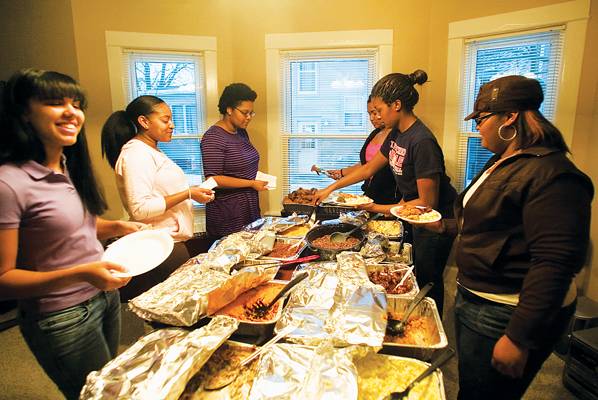Faculty reopens Black Cultural Center thanks to dedication if ISU alumni

Students get together at the Black Cultural Center to eat soul food on Sunday, February 24th. The event was the last major event for the Black Student Association for Black History Month. Photo: Manfred Strait/Iowa State Daily.
February 12, 2009
Strengths and opportunities.
The two words hold power, said Associate Dean of Students Mary Jo Gonzales. Together they describe the success of multicultural affairs on campus and the growing list of services Iowa State provides. One of those strengths is the Black Cultural Center.
Incorporated in August of 1969, the Black Cultural Center started out as a space for black students to use and build solidarity as the minority of a largely white student population. At the center, students were able to share struggles and feel they had a place to belong.
The Black Cultural Center is located at 517 Welch Ave. It was not until January of 1970 that the university took ownership of the house. The following September, the building was dedicated. Structural damage to the house from water and mold began to take toll on the building in the late ’90s, and by 2000 the facility was no longer suitable for use. A “Challenge Fund” in 2001 made attempts to raise the money necessary for maintenance repairs but could not gain enough contributions, and the center was closed in 2003.
As the house faced threats of continued deterioration, a new initiative led by alumni gave the house a second chance in 2005.
“The rich history of multicultural services are part of Iowa State’s culture,” Gonzales said. “The alumni reinvigoration is a tribute to their dedication.”
With the house back in usable condition, the building was rededicated on Feb. 14, 2007. The Black Cultural Center had returned home and alumni support singled the importance of the facility and its services.
“If you look at research of students of color, they lag behind. Part of our responsibility is students are successful in a predominately white university,” said Santos Nunez Galicia, director of multicultural student affairs. “The Black Cultural Center really ensures they are successful.”
Gonzales calls the center “one of the gems on campus.” The description is fitting as Iowa State’s multicultural services stand out among many top universities across the country, a factor that originally drew Galicia to the program.
“The first priority is the students and the ISU community,” she said. “ISU really cares about students.”
Creating a community where every student feels welcome is a campus priority, and a number of programs have been set up to fulfill the initiative. The university awards more than 200 scholarships annually to minority students, both in and out of state, which is “ahead of the curve,” Gonzales said. Also, nearly 90 clubs and organizations are multiculturally-based. The center is just one of the many services.
“I would encourage students to think about using the Black Cultural Center. Not many institutions have that,” Galicia said.
Both Gonzales and Galicia emphasize that the center is available for use for all students, not just those who are black, and that they wish to see more activity at the house.
Events at the Black Cultural Center:
Stairwell Art Project: art on display through February
Soul Food Fest: teaming up with campus dining centers, date to be determined
Lectures including Gloria Ladson-Billings on Friday
— House acquired September, 1969
— University took ownership of house, January 1970
— House dedicated, September 1970
— Construction for repairs, 1996
— Rededication ceremony, April 1997
— Repairs needed, 2000
— “Challenge Fund” for repairs begins, 2001
— Closes from structural damages, 2003
— “Construction Before Destruction” repair campaign, 2005
— Rededication Ceremony, February 2007






